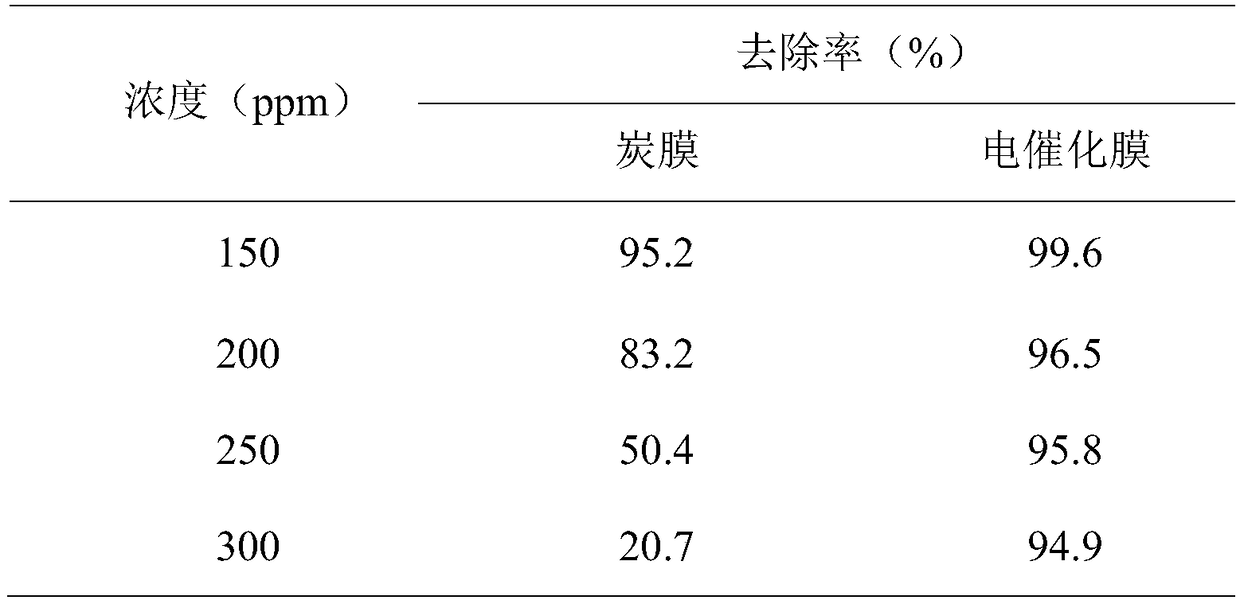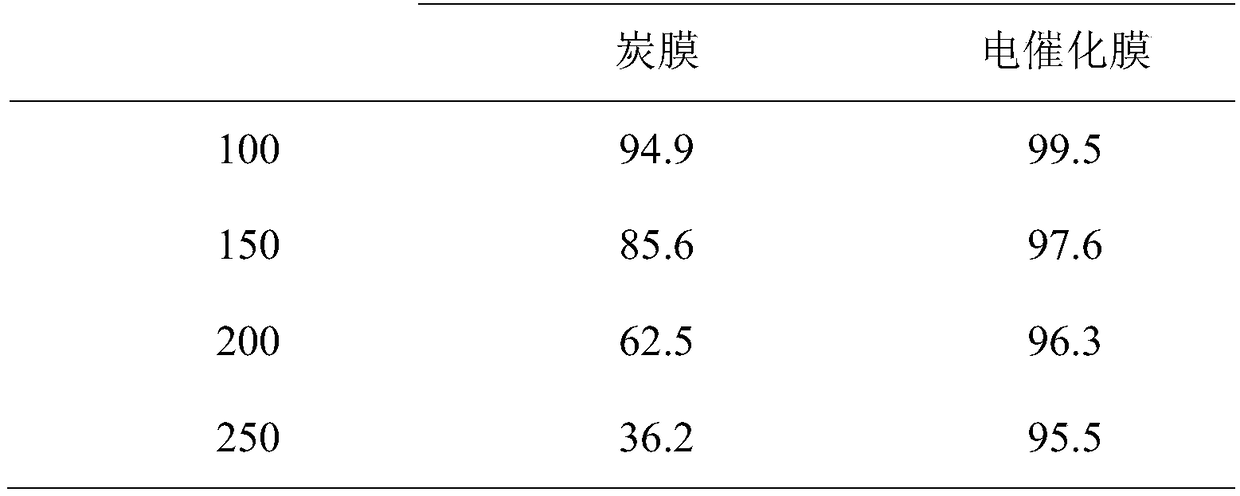Method for preparing electric catalytic carbon membrane through dynamic electrochemical deposition
An electrochemical and electrodeposition technology, applied in the field of membrane separation, can solve the problems of insufficient electrochemical degradation ability of carbon membranes, achieve the effects of low cost, enhanced processing capacity, and accelerated industrialization process
- Summary
- Abstract
- Description
- Claims
- Application Information
AI Technical Summary
Problems solved by technology
Method used
Image
Examples
Embodiment 1
[0035] Soak a single-channel tubular carbon membrane (average pore size: 0.4 μm, porosity: 40%) in nitric acid aqueous solution (volume ratio of nitric acid to water: 1:2.5) for 2 hours, wash with dewatered water until neutral, and place at 60°C Dry in oven for 2h. Add zinc sulfate, citric acid and sodium hydroxide into water respectively to configure an electrodeposition solution, wherein the concentrations of zinc sulfate, citric acid and sodium hydroxide are respectively 1.0%, 0.5% and 1.0% (mass percentage). The carbon film is set as the anode, and the stainless steel sheet is set as the cathode, and immersed in the electrodeposition solution at the same time to form a two-electrode electrodeposition system. Place the tubular carbon membrane in the electrodeposition solution with the tubular central axis perpendicular to the ground, seal the bottom end of the tubular carbon membrane, connect the other end to the hose of the peristaltic pump, and use the negative pressure g...
Embodiment 2
[0039] Soak the seven-channel tubular carbon membrane (average pore size: 0.6 μm, porosity: 42%) in nitric acid aqueous solution (volume ratio of nitric acid to water: 1:2) for 1 hour, wash with dewatered water until neutral, and place at 80°C Dry in oven for 1h. Add tin tetrachloride, ammonium thiocyanate and potassium hydroxide to water respectively to configure an electrodeposition solution, wherein the concentrations of tin tetrachloride, ammonium thiocyanate and potassium hydroxide are 2.0%, 1.5%, and 4.0% respectively (mass percentage). The carbon film is set as the working electrode, the platinum sheet electrode is set as the counter electrode, and the calomel electrode is set as the reference electrode, and they are immersed in the electrodeposition solution at the same time to form a three-electrode electrodeposition system. Place in the electrodeposition liquid, seal the bottom end of the tubular carbon membrane, connect each channel to the hose of the peristaltic p...
Embodiment 3
[0044] Soak the non-hollow plate-shaped carbon membrane (average pore size: 0.8 μm, porosity: 41%) in nitric acid aqueous solution (the volume ratio of nitric acid to water is 1:4) for 3 hours, wash it with dewatered water until it is neutral, and place it at 50 ℃ oven dry for 2h. Add cobalt chloride, sulfosalicylic acid and sodium hydroxide into water respectively to configure an electrodeposition solution, wherein the concentrations of cobalt chloride, sulfosalicylic acid and sodium hydroxide are 3.0%, 1.5%, and 5.0% respectively (mass percentage). The carbon membrane is set as the anode, and the stainless steel mesh is set as the cathode, and is immersed in the electrodeposition solution at the same time to form a two-electrode electrodeposition system. The negative pressure generated by the peristaltic pump on one side of the carbon membrane makes the electrodeposition solution permeate from the other side of the carbon membrane. To the other side of the carbon film, dyna...
PUM
| Property | Measurement | Unit |
|---|---|---|
| porosity | aaaaa | aaaaa |
Abstract
Description
Claims
Application Information
 Login to View More
Login to View More - R&D
- Intellectual Property
- Life Sciences
- Materials
- Tech Scout
- Unparalleled Data Quality
- Higher Quality Content
- 60% Fewer Hallucinations
Browse by: Latest US Patents, China's latest patents, Technical Efficacy Thesaurus, Application Domain, Technology Topic, Popular Technical Reports.
© 2025 PatSnap. All rights reserved.Legal|Privacy policy|Modern Slavery Act Transparency Statement|Sitemap|About US| Contact US: help@patsnap.com



